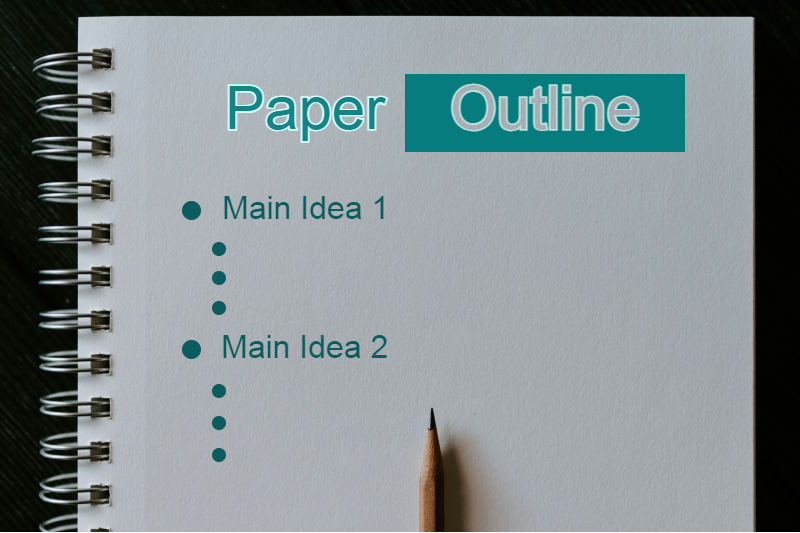Tips on Creating an Effective Academic Paper Outline
February 23, 2024| Category: Writing Tips
Creating an academic paper outline is akin to charting a course for your writing adventure. In fact, it acts as a master plan, guaranteeing that every piece of information you intend to present is orderly arranged and readily at hand. An effectively designed outline enhances your writing process by allowing you to:
- organize your ideas;
- understand how your thoughts flow and connect;
- ensure that no important points are missing.

Guide to Crafting an Academic Paper Outline
Importantly, embarking on your paper outline involves a few straightforward steps:
- Choose your topic: Determine the central theme of your paper.
- Brainstorm ideas: List all the points and arguments you wish to explore.
- Group related thoughts: Unite similar ideas to form categories.
- Prioritize your points: Determine the order in which your ideas will be presented. Determine the initial information the reader should encounter and identify the most persuasive arguments. Consider the most effective way to conclude your paper.
- Designate headings and subheadings: Create clear and impactful headings and subheadings to guide the reader through your paper.
- Select your format: Decide on the structure of your outline, whether it be alphanumeric, full-sentence, or decimal format, to best suit your paper’s needs.
Evidently, these guidelines will improve the writing process, helping you create an academic paper distinguished by its clear organization, structured approach, and engaging content.
The Value of a Strong Outline
Undoubtedly, a well-crafted outline is crucial for several reasons:
- First, it keeps you organized and on track, enhancing the coherence of your final paper. Consider an outline as a guiding structure that supports your writing process instead of restricting it. As you engage more with your research and gather more information, be ready to adjust your outline to accommodate the changing shape of your document.
- Second, an outline assists in organizing various thoughts regarding your topic. Given that most research questions can be approached from multiple angles, an outline helps you determine the most effective analytical paths to uncover the most significant findings.
- Third, a comprehensive and clear outline acts as a navigational tool to realign your writing if you find yourself veering off course from the main research question.
The Structure of Your Academic Paper Outline
Academic paper outlines typically come in three main formats: alphanumeric, full-sentence, and decimal. The choice between them hinges on the formatting preferences and writing style.
Firstly, the alphanumeric format is the most popular, employing a mix of Roman numerals, uppercase letters, Arabic numerals, and lowercase letters to organize information sequentially. Instead of complete sentences, this format typically uses brief phrases to outline content.
For instance:
BODY PARAGRAPH 1
- Main Argument
- Supporting Argument
- Detail of Supporting Argument
- Supporting Argument
Secondly, the full-sentence format mirrors the alphanumeric structure but is distinct in that it employs full sentences instead of brief notes to detail the content.
For example:
- The first body paragraph of the academic paper:
- The initial piece of evidence supporting the main argument is presented comprehensively.
- A detailed discussion on the evidence provided in the first point, elaborating on its relevance and implications.
- An additional elaboration to wrap up the discussion on the evidence introduced initially, tying back to the main argument.
Thirdly, the decimal outline adopts a format akin to the alphanumeric one, yet it utilizes a distinct decimal numbering system for organizing sections and sub-sections: 1, 1.1, 1.2, and so forth. In this style, the text is presented in brief notes rather than full sentences.
For instance:
1. Body paragraph one
1.1. First main point
1.1.1. Detail supporting the first main point
1.1.2. Additional detail supporting the first main point
1.2. Second main point
Linguistic Considerations in Writing Academic Paper Outlines
The employment of clear and precise language is crucial when developing an academic paper outline. Consequently, four essential linguistic principles – parallelism, coordination, subordination, and division – must be considered to develop an effectively organized outline.
Parallelism: Aim for grammatical consistency. Parallelism involves using the same grammatical structure for points and sub-points within your outline. This implies that if your initial main point begins with a verb, you should consistently use verbs for your subsequent sub-points to preserve a uniform grammatical structure.
Coordination: Ensure equal importance among points. When organizing your outline, make sure that your subheadings, and the points under them, carry equal weight. This principle ensures that you give each point and sub-point appropriate attention and each of them contributes equally to the overall argument or discussion.
Subordination: Structure from broad to specific. Subordination helps distinguish between general and specific points. Your main headings should introduce broad ideas, and as you create sub-points, they should provide more detailed and specific information, narrowing down the focus.
Division: Segment information into manageable sub-points. Each of your headings should be broken down into at least two subsections. Evidently, the number of subsections is not strictly limited, but you have to remember that these are the points you will ultimately structure into paragraphs. In other words, it is pivotal to maintain a succinct and focused structure to prevent your paper from becoming overwhelmed with excessive sub-points.
In summary, following these language principles enables you to craft an academic paper outline that is both coherent and logically organized, facilitating your writing process and aligning with the expectations of your audience.
